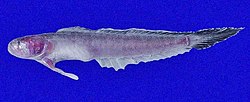| Akko | |
|---|---|
 | |
| Akko brevis | |
| Scientific classification | |
| Domain: | Eukaryota |
| Kingdom: | Animalia |
| Phylum: | Chordata |
| Class: | Actinopterygii |
| Order: | Gobiiformes |
| Family: | Gobiidae |
| Genus: | Akko Birdsong & C. R. Robins, 1995 |
| Type species | |
| Akko dionaea Birdsong & C. R. Robins, 1995 | |
Akko is a genus of gobies native to the Atlantic and Pacific coasts of the Americas.